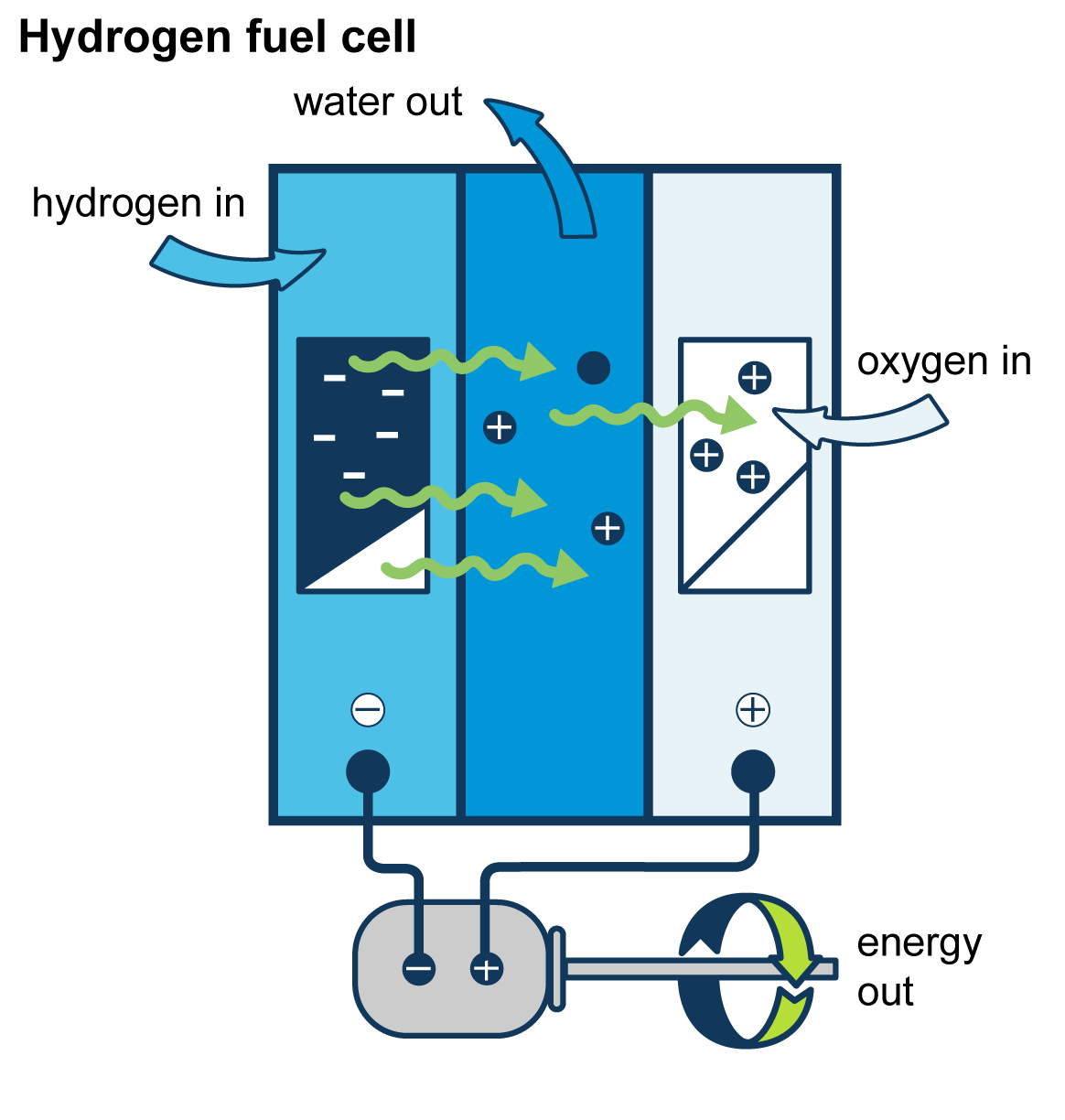Harnessing the power of hydrogen fuel cell technology holds the promise of a revolution in electricity generation. Imagine a world where clean, sustainable energy is produced without any harmful emissions or excessive reliance on finite resources. This captivating concept has become a reality with hydrogen fuel cells, offering a glimmer of hope amidst our global climate crisis. With a touch of alchemy, these extraordinary devices convert hydrogen and oxygen into electrical energy, casting aside the shackles of traditional fossil fuel-based electricity generation. In this article, we will delve into the intricate workings of hydrogen fuel cells, exploring the boundless potential they hold in shaping a greener and more efficient future for our planet. Dive into this transformative realm where hydrogen fuel cells illuminate our path to a brighter and cleaner power generation landscape.
A fuel cell uses the chemical energy of hydrogen or other fuels to cleanly and efficiently produce electricity. If hydrogen is the fuel, the only products are electricity, water, and heat. Fuel cells are unique in terms of the variety of their potential applications; they can use a wide range of fuels and feedstocks and can provide power for systems as large as a utility power station and as small as a laptop computer.
Why Study Fuel Cells
Fuel cells can be used in a wide range of applications, providing power for applications across multiple sectors, including transportation, industrial/commercial/residential buildings, and long-term energy storage for the grid in reversible systems.
Fuel cells have several benefits over conventional combustion-based technologies currently used in many power plants and vehicles. Fuel cells can operate at higher efficiencies than combustion engines and can convert the chemical energy in the fuel directly to electrical energy with efficiencies capable of exceeding 60%. Fuel cells have lower or zero emissions compared to combustion engines. Hydrogen fuel cells emit only water, addressing critical climate challenges as there are no carbon dioxide emissions. There also are no air pollutants that create smog and cause health problems at the point of operation. Fuel cells are quiet during operation as they have few moving parts.
How Fuel Cells Work
Fuel cells work like batteries, but they do not run down or need recharging. They produce electricity and heat as long as fuel is supplied. A fuel cell consists of two electrodes—a negative electrode (or anode) and a positive electrode (or cathode)—sandwiched around an electrolyte. A fuel, such as hydrogen, is fed to the anode, and air is fed to the cathode. In a hydrogen fuel cell, a catalyst at the anode separates hydrogen molecules into protons and electrons, which take different paths to the cathode. The electrons go through an external circuit, creating a flow of electricity. The protons migrate through the electrolyte to the cathode, where they unite with oxygen and the electrons to produce water and heat. Learn more about:
View the Hydrogen and Fuel Cell Technologies Office’s fuel cell animation to see how a fuel cell operates.
Research and Development Goals
The U.S. Department of Energy (DOE) is working closely with its national laboratories, universities, and industry partners to overcome critical technical barriers to fuel cell development. Cost, performance, and durability are still key challenges in the fuel cell industry. View related links that provide details about DOE-funded fuel cell activities.
- Cost—Research, development, and demonstration (RD&D) focuses on the development of low-cost fuel cell stack and balance of plant (BOP) components and advanced high-volume manufacturing approaches to reduce overall system cost. Platinum represents one of the largest cost components of a direct hydrogen fueled polymer electrolyte membrane fuel cell, so there is emphasis on approaches that will increase activity and utilization and reduce the content of current platinum group metal (PGM) and PGM-alloy catalysts, as well as PGM-free catalyst approaches for long-term applications.
- Performance—To improve fuel cell efficiency and performance, RD&D focuses on innovative materials and integration strategies. Efforts include developing ion-exchange membrane electrolytes with enhanced efficiency and durability at reduced cost; improving membrane electrode assemblies (MEAs) with high power density through integration of state-of-the-art MEA components; modeling to understand system design and operating conditions; and developing stacks with high efficiency at rated power and high-performing BOP components, such as air management components with low parasitic losses.
- Durability—Fuel cell applications generally require adequate performance to be maintained over long periods of time. DOE has set ultimate targets for fuel cell system lifetime under realistic operating conditions at 8,000 hours for light-duty vehicles, 30,000 hours for heavy-duty trucks, and 80,000 hours for distributed power systems. In the most demanding applications, system reliability and robustness is required under dynamic and harsh operating conditions. Realistic operating conditions include starting and stopping, freezing and thawing, impurities in the fuel and air, and humidity and dynamic load cycles that result in stresses on the chemical and mechanical stability of the fuel cell system materials and components. RD&D focuses on identifying and understanding the fuel cell degradation mechanisms and developing materials and strategies to mitigate their effects.
1. Harnessing the Power of Hydrogen: Unleashing the Potential of Fuel Cell Electricity Generation
As the world continues to search for cleaner and more sustainable forms of energy, the power of hydrogen and its potential in fuel cell electricity generation cannot be underestimated. Contrary to popular belief, fuel cells are not a new concept; they have been around for more than a century. However, recent advancements in technology have allowed us to explore hydrogen’s capabilities in a more efficient and practical manner.
Fuel cells are devices that convert the chemical energy of hydrogen and oxygen into usable electricity, without any harmful emissions or pollution. Harnessing the power of hydrogen through fuel cells offers several advantages that make it a promising solution for our future energy needs.
- Clean Energy: Hydrogen fuel cells produce only water and heat as byproducts, making them environmentally friendly and reducing our carbon footprint.
- Efficiency: Fuel cells are highly efficient, with conversion rates that can exceed 50%. This surpasses traditional combustion engines and makes them a viable option for various applications.
- Flexible Applications: Fuel cells can be used in a wide range of sectors, from transportation and industrial processes to residential electricity generation.
These are just a few examples of how we can harness the power of hydrogen
2. A Paradigm Shift: Revolutionizing Energy Production through Hydrogen Fuel Cell Technology
Hydrogen has many actual and potential uses
Hydrogen is currently used in industrial processes, as rocket fuel, and in fuel cells for electricity generation and powering vehicles. Operators of several natural gas-fired power plants are exploring the use of hydrogen to supplement or replace natural gas. Hydrogen has the potential for effectively storing energy for electric power generation.
Hydrogen is used in industrial processes
Nearly all of the hydrogen consumed in the United States is used by industry for refining petroleum, treating metals, producing fertilizer and other chemicals, and processing foods. U.S. petroleum refineries use hydrogen to lower the sulfur content of fuels. Biofuel producers also use hydrogen to produce hydrotreated vegetable oil (HVO) for use as renewable diesel.
Hydrogen fuel cells produce electricity
Hydrogen fuel cells produce electricity by combining hydrogen and oxygen atoms. The hydrogen reacts with oxygen across an electrochemical cell— similar to a battery—to produce electricity, water, and small amounts of heat.
Hydrogen fuel cells are currently used to power the electrical systems on spacecraft and to supply electricity on earth. Small fuel cells have been developed to power electronic devices, such as laptop computers and cell phones. Several vehicle manufacturers have developed fuel cells to power vehicles. Fuel cells can potentially provide electricity for emergency power in buildings and for remote locations that are not connected to electric power grids.
Fuel cell power plants
As of the end of December 2022, the United States had about 205 operating fuel cell electric power generators at 147 facilities with about 350 megawatts (MW) of total nameplate electric generation capacity. The nameplate capacities range from the largest single-fuel cell, with about 17 MW capacity—the Bridgeport Fuel Cell, LLC in Connecticut—to 10 fuel cells each with 0.1 MW capacity at the California Institute of Technology. The majority of all operating fuel cells use pipeline natural gas as the hydrogen source, but one uses landfill gas and four use biogas from wastewater treatment.
Fuel cells for vehicles
Hydrogen is considered an alternative vehicle fuel under the Energy Policy Act of 1992. The interest in hydrogen as an alternative transportation fuel stems primarily from its potential to power fuel cells in zero-emission vehicles (vehicles with no emissions of air pollutants). A fuel cell may be two to three times more efficient than an internal combustion engine running on gasoline. Several vehicle manufacturers have hydrogen fuel cell-vehicles available in California and Hawaii. A few test vehicles are available to organizations with access to hydrogen-fueling stations.
The high cost of fuel cells and the limited availability of hydrogen fueling stations have limited the number of hydrogen-fueled vehicles in use today. Production of hydrogen-fueled vehicles is limited because people won’t buy those vehicles if hydrogen refueling stations are not easily accessible, and companies won’t build refueling stations if they don’t have customers with hydrogen-fueled vehicles. The United States has about 56 hydrogen-vehicle-fueling stations, all of which are in California. The State of California’s Advanced Clean Cars Program includes assistance for establishing publicly accessible hydrogen vehicle fueling-stations throughout California to promote a consumer market for zero-emission fuel cell vehicles.
Hydrogen can be burned for electricity generation and heating
Hydrogen combustion for electric power generation and for space heating are potential uses of pure hydrogen or hydrogen-rich blends with natural gas. However, use of hydrogen and hydrogen-blends in existing natural gas distribution infrastructure and combustion equipment poses a number of challenges related to materials compatibility and combustion characteristics. Progress has been made with modifying natural gas burners in commercially available combustion turbines to accommodate high-hydrogen blends (up to 100% hydrogen), but continued research, development, and demonstration (RD&D) is needed before hydrogen will qualify for utility-scale power generation. Several power plants in the United States have announced plans to operate on a natural gas-hydrogen fuel mixture in combustion-gas turbines. One example is the Long Ridge Energy Generation Project in Ohio. RD&D is also needed to assess the compatibility of using hydrogen and hydrogen–natural gas blends in heating appliances.
Hydrogen can be used for energy storage
Hydrogen storage is an important technology to enable hydrogen use across the U.S. economy. Hydrogen may be stored as a:
- Gas—Hydrogen can be stored as a gas in large volumes in natural geological formations—salt caverns, lined hard rock caverns, depleted oil and natural gas fields, and aquifers. Gaseous hydrogen may also be stored in relatively smaller volumes in pressurized, stationary or portable tanks, and in dedicated hydrogen gas pipeline infrastructure. Gaseous storage is currently the most common and the most likely option for expanding hydrogen storage for most uses of hydrogen as an energy source.
- Liquid—Hydrogen can be liquefied by cooling it to below −423oF (−253oC). The liquefied hydrogen can be stored in super-cooled (cryogenic) tanks for transportation applications in fuel cell vehicles or directly as fuel in truck, rail, marine, and rocket engines—NASA has the two largest liquid hydrogen storage tanks in the world. Hydrogen liquefaction and cyrogenic liquid storage is an energy intensive and expensive process.
Hydrogen has the potential to facilitate decarbonization of the electric power sector by storing energy produced with renewable energy for use over days or weeks. Hydrogen could be produced with renewable resources when renewable energy production is high and could be stored to generate electricity when renewable resources are limited and electricity demand is high. One example is the Advanced Clean Energy Storage project in Utah, which plans to store large volumes of gaseous hydrogen produced from renewable resources for long-term seasonal energy storage.

